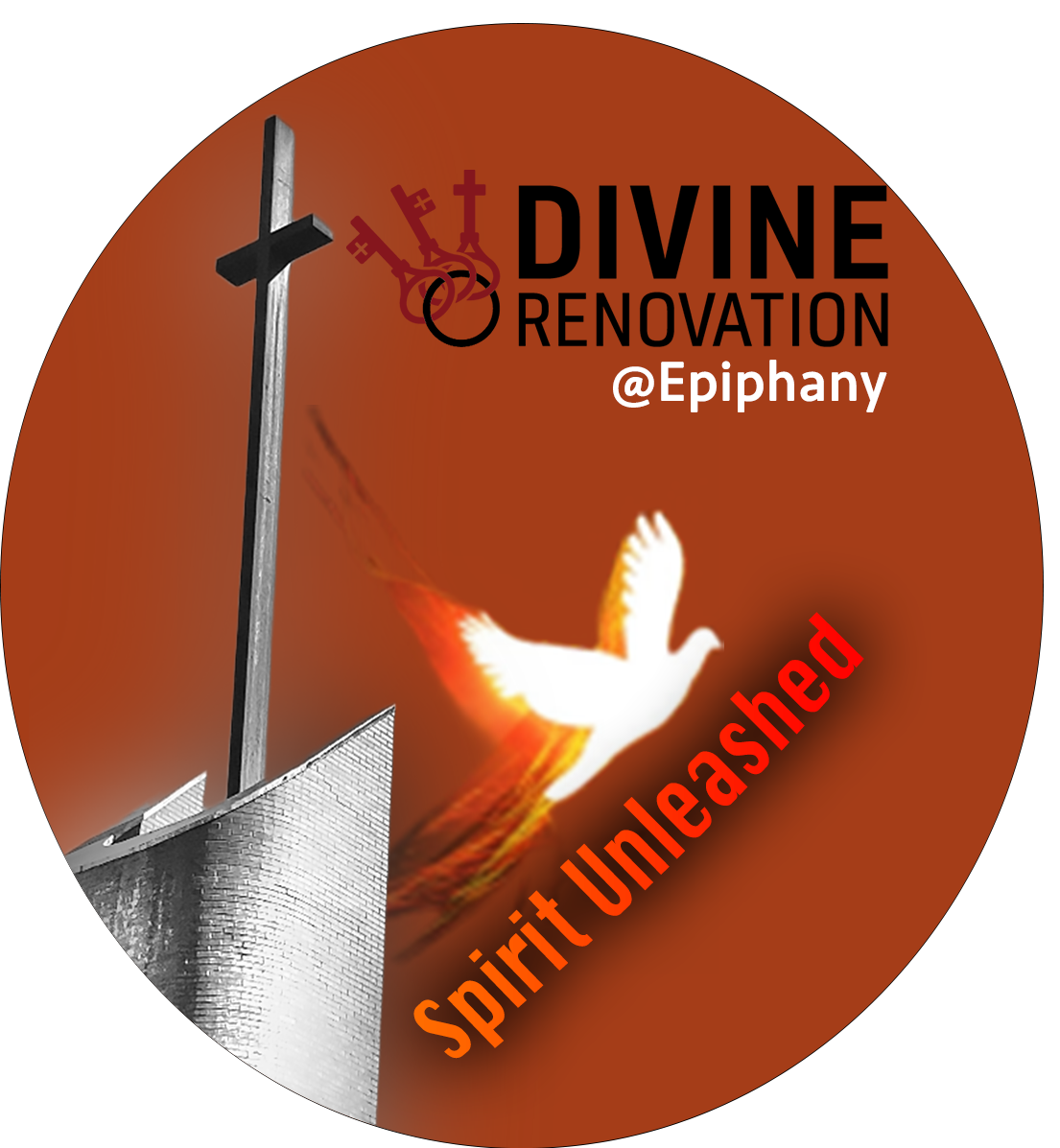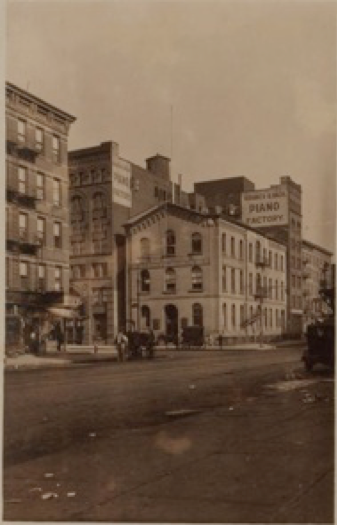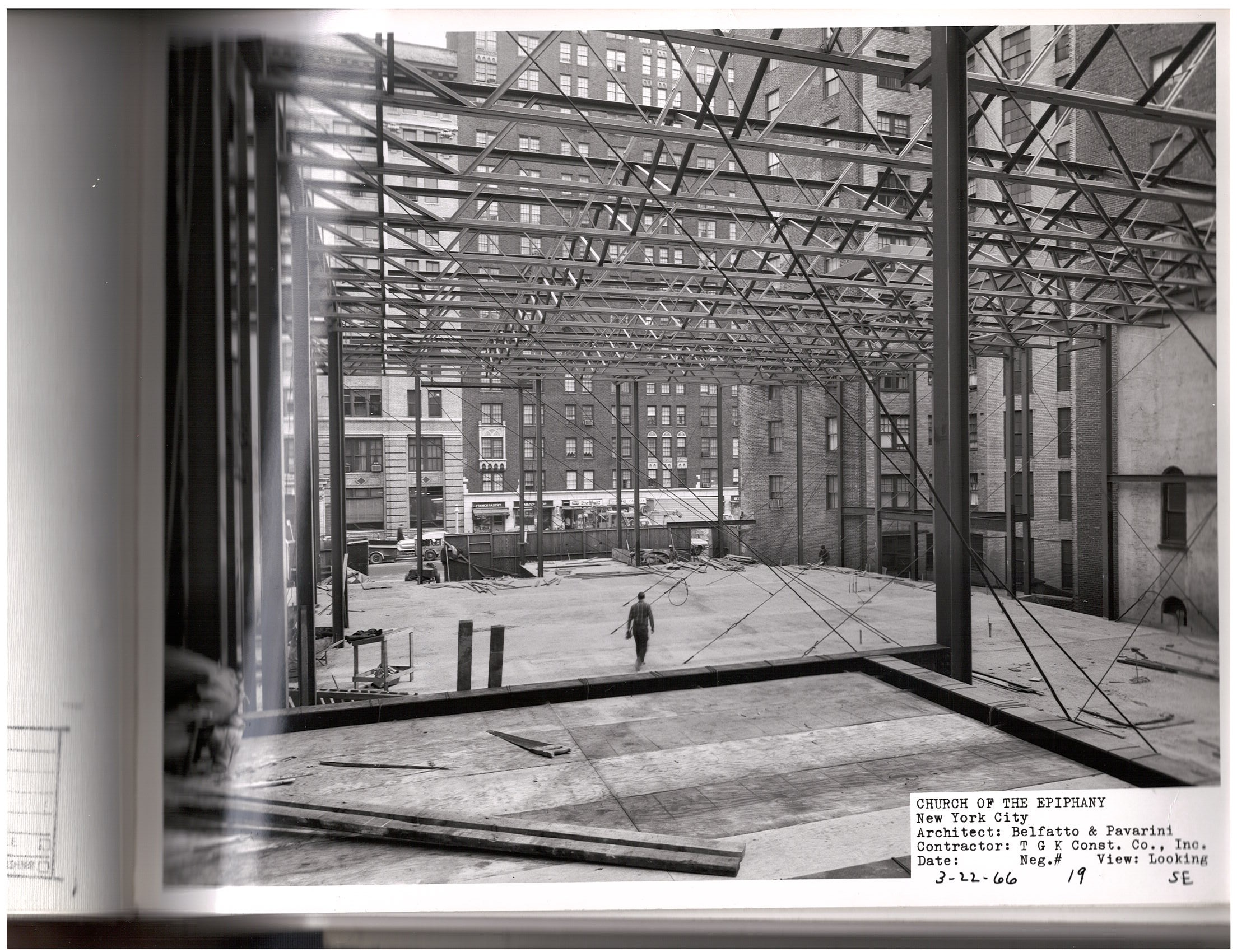A Family for
over 150 Years
In the 1860's it was difficult being a Catholic in New York. There were not enough churches to adequately serve the needs of the faithful. Four Manhattan parishes in particular, St. Mary's on Grand Street, St. Ann's on East 12th Street, Immaculate Conception on East 14th Street, and St. Stephen's on East 28th Street, were truly "bursting at the seams". In those days it was not uncommon for some parishes, in order to create opportunities for all the parishioners to satisfy their Sunday obligation, to offer Mass alternately between the church proper and the parish hall, beginning from as early as 4:00 A.M. right through the late morning. The usual practice was to start Mass on the hour in the church proper, and on the half-hour in the parish hall. This could result in as many as fourteen Sunday Masses being celebrated in a single parish, with each of them packed with worshippers. The strain on the parish clergy, as well as the church facilities was considerable.
One priest of the Archdiocese who was acutely aware of this situation was Fr. Richard L. Burtsell, an energetic young man, still in his late 20's, who was then serving as parochial vicar at St. Ann's. In the mid-1860's, the horrors of the Civil War had ended, and some semblance of tranquility was returning to the city, which had seen not only the draft riots, but also a violent gun battle at the Union Steam Works, located at 2nd Avenue and East 22nd Street (where Epiphany Church stands today!) Cardinal McCloskey, aware of the need to build more churches, was eager to hear from New York's priests, seeking input as to where best to build. Fr. Burtsell, having demonstrated great missionary zeal in his work at St. Ann's, suggested a great need to create a new parish out of the northern portion of St. Ann's territory, which then reached into the East 20's where it met the southern boundary of St. Stephen's. Accordingly, when the Cardinal did exactly that, he appointed Fr. Burtsell as the first pastor of the new parish. The newly-created parochial territory ran from the north side of East 18th Street to the south side of East 24th Street, and from the east side of Broadway to the East River.
Immediately, the energetic new shepherd sought out a temporary home for his new flock. He was able to find facilities on the northwestern corner of 2nd Avenue and East 23rd Street, signing a lease on the downstairs auditorium of the DeMilt Dispensary, a community clinic affiliated with New York University (sort of the 19th Century equivalent of the "MedRite" facility which stands opposite the church today). After having this auditorium properly furnished as a chapel, Fr. Burtsell celebrated the first Mass of the new parish. Because this Mass took place on January 5, 1868, the eve of the Feast of the Epiphany of the Lord, Cardinal McCloskey, in the issuance of the Decree of Canonical Erection of the new parish, officially named it the "Church of the Epiphany".
DeMilt Dispensary—First Mass in 1868
With the same energy he put into getting the temporary chapel, Fr. Burtsell immediately set about building a proper, permanent sanctuary for the new parish. He arranged for the purchasing of lots along 2nd Avenue and on East 21st and East 22nd Streets, hired the prestigious architectural firm of N. LeBrun & Sons (designer of many New York churches as well as the Metropolitan Life Tower) to design the church, and had the cornerstone laid on May 30, 1869. With amazing speed, a beautiful church of imitation Lombard design, 76 feet wide, 145 feet deep, and made of granite and sandstone, rose from the street, topped off by a bell tower at the northeast corner. With a nod to the new parish's patronal liturgical feast, this tower was crowned at its apex with a beautiful "Stella Orientalis" (Star of the East), in honor of that miraculous celestial entity which led the Magi to the newborn Christ at Bethlehem. Not wanting to have anything lacking in anticipation of the new church's opening, Fr. Burtsell located a 13 year old, second-hand, two-manual H. C. Stuart pipe organ and opted to have it installed immediately, rather than wait to commission a new instrument.
Finally, on April 3, 1870, the Church of the Epiphany was formally opened and dedicated with ceremonies led by the Vicar General of the Archdiocese, Msgr. William Starrs, and with Fr. McGlynn, pastor of St. Stephen's, as celebrant of the Mass. Because Epiphany parish was created, in a true sense, as a "daughter congregation" of St. Ann's, a large contingent from that parish, both clergy and laity, partook of the occasion. Fr. Thomas Preston, one of the priests of St. Ann's, preached the homily, taking as his theme, "Where is He that is born the King of the Jews? For we have come to adore Him". Providing music for the occasion, Professor Dachauer, Director of Music and Organist at St. Ann's, came to Epiphany with his entire choir in tow, who sang the professor's own "Mass in C Minor for Organ and Orchestra", with orchestral accompaniment conducted by his assistant, Professor Eben. Twelve days later, on April 25, 1870, at the 10:30 A.M. High Mass, Epiphany inaugurated its own parish music ministry with the debut of the first parish choir, under the direction of Giovanni Aberle-Sforza as Director of Music and Organist. On that occasion, the Mass setting used was the "Mass in G" by composer Harrison Millard, who was himself Music Director at neighboring St. Stephen's Church on East 28th Street.
Church of the Epiphany 1870
Interior, first Church of the Epiphany
The parish grew steadily over the next ninety years, entering the 20th century. In 1900 it was reported that an average of 300 people attended the 6am Sunday Mass; 800 at the 7am Mass; and 1200 at the 8am Mass!
In the early 20th century, an increasing number of Italian immigrants were arriving in New York City and in Epiphany Parish. The pastor, Msgr. McMahon, seeking help in caring for their spiritual and catechetical needs, requested the addition of specifically Italian-speaking priests to the parish staff, who could minister to them in their own tongue. Soon, additional Sunday Masses, with sermons in Italian, were being celebrated in the church auditorium. For the religious instruction of the Italian children, Msgr. McMahon requested that the Missionary Sisters of the Sacred Heart of Jesus, among them Mother Frances Xavier Cabrini, who was then organizing Columbus Hospital, begin a program of children's catechesis with classes held in the auditorium, which after her death in 1917 and canonization in 1946, was renamed "Mother Cabrini Hall".
One vitally important capital improvement undertaken early on by a succeeding pastor (Fr Joseph S O’Connell) was the design and construction of a new rectory. Since its founding in 1868, the clergy of the parish had kept "temporary" lodgings in a pair of joined-together tenement houses. A brand-new, purpose-built residence at 239 East 21st Street was completed and furnished. On April 1, 1937, the new rectory was blessed and opened for occupancy. It continues to serve as the home for Epiphany's clergy today, as well as housing the administrative offices of the parish on the ground floor.
The rectory has provided a comfortable residence for Epiphany’s priests since 1937.
In January 1943 Epiphany Parish celebrated its 75th Anniversary. To mark the occasion, Fr. O'Connell, fresh from the success of building the new rectory, embarked on an ambitious plan of updating and modernization of the parish plant. The interior of the church was physically overhauled with new heating, lighting, etc., and thoroughly redecorated. In 1947, the parish school was given a gut renovation, with the interior stripped down to the frame and rebuilt from within, with only the original outer shell of the building remaining. Fr. O'Connell was particularly pleased with this result, stating he wanted a parish school that was well equipped for the demands of modern education.
Fr O’Connell’s successor was Msgr Farricker, who took on the role of pastor after 18 energetic years as parochial vicar of the parish. He enhanced the physical plant of the church, built a new auditorium, and built a convent for the Sister of Charity who staffed the school.
Throughout the 20th century, Epiphany had steadily grown larger and larger as a parish. By 1955, the first full calendar year of Msgr. Farricker's pastorate, Epiphany had almost become like one of those "bursting at the seams" parishes whose relief it had been created to provide. Statistics in the late 1950's showed the seven Sunday Masses had an average combined attendance of over 3,500, the parish Holy Name Society had 425 members, the Rosary Altar Society 362 members, the League of the Sacred Heart 150 members, and the school's Mother's Club 135 members. By 1962 the corps of altar boys reached 120. With all these active parishioners Msgr. Farricker cultivated an energetic spiritual and devotional life for the parish, regularly scheduling Lenten missions, as well as entire Triduums built around major feast days such as All Souls Day, Immaculate Conception, and of course, Epiphany. When church discipline began to allow for evening Masses, a 5:30 P.M. Mass for Holy Days of Obligation was added to the schedule. First Friday and First Saturday devotions were averaging 550 in monthly attendance.
Bitter Depths...
and a Glorious Rebirth
By December 1963, one could be forgiven for thinking that things couldn't get better at Epiphany. The congregation was swelling, the parishioners fervent and generous, the parish finances sound. As if to show how fortunes can turn in an instant, the continuation of all this parochial serenity would, in a matter of five hours on a single day, suddenly be cast into doubt.
In the late afternoon of December 20, 1963, the school children, attending a Christmas party in the auditorium, reported smelling smoke. A priest's investigation revealed that the church was ablaze. As the police and fire department reports would later attest, a man, Oliver Penn, reportedly recently discharged from Bellevue and alleged to have been intoxicated, had slipped into an unoccupied confessional and lit a cigarette, igniting the curtain, with the flames spreading rapidly. By 8:00 P.M. five alarm companies were on the scene in the frigid, icy weather, attempting to control what had become a hopeless conflagration. By the following morning, the beautiful Church of the Epiphany had been reduced to a charred shell.
December 20, 1963 fire that destroyed the Church
Epiphany interior after fire 1963
Fireman J. De Bellonia surveys the ruins of the fire-gutted Epiphany Roman Catholic Church on 2nd Avenue.
That very night, before the fire had even been declared under control, Msgr. Farricker, in the presence of the assisting clergy and parish trustees, made the conscious decision to have the church rebuilt, in his time, on his watch. Christmas Midnight Mass was celebrated in the auditorium of the Metropolitan Life Insurance Company, and over the following months the "homeless parishioners" of Epiphany would alternately celebrate Mass and the sacraments in the Castro Convertible showroom on East 23rd Street and a Whelan's Drugstore on East 20th Street before finally getting a steady temporary home in the chapel of the Catholic Charities building at Lexington Avenue and East 22nd Street.
Assessing the cost of the new church against the proceeds from the insurance settlement, Msgr. Farricker determined that the parish would be caught $300,000 short. A vigorous fundraising campaign was begun among the parishioners, with their generosity producing well over $564,000! On September 19, 1965, in the company of the clergy of both Epiphany and neighboring parishes, as well as a large group of parishioners, Msgr. Farricker stood in the empty lot that had only recently been cleared of the rubble of the old church, and invoked God's blessing on the groundbreaking for the new church. Speaking into microphones, which caused his voice to echo all across the intersection of 2nd Avenue and East 22nd Street, he gazed Heavenward and prayed:
"Bless O Lord this site,
on which formerly stood the glorious
Church of the Epiphany,
and make here to rise a monument
to your Holy Name for us to adore
and to worship you in the years to come.
Amen".
Msgr Farriker blesses site of new church, which was completed in 1966, three years after the fire.
The new church immediately began its rapid rise. Designed by the architectural firm of Belfatto and Pavarini, the edifice was of a stark, contemporary Italianate design, made of a steel frame, semi-glazed brick, and bronzed, anodized aluminum, and a floor made of reinforced concrete, with the intention of rendering it fireproof. The seating capacity is approximately 700. The main doors of the church opened upon a large open plaza created by the purchasing of three adjacent properties (the same properties Msgr. McMahon had so desperately wanted to acquire in 1903!) and demolishing their existing structures, after financially compensating the commercial and residential occupants for the cost of their relocation. Above the main doors, the sole remnant of the Epiphany Window that survived the fire, the figure of the Madonna and Child, was incorporated into a new work of modern stained glass, thereby by creating a visual mark of continuity between the old and new churches. A fragment of the altar from the original church was imbedded in the floor in front of the main altar of the new church, creating a similar effect. The brilliant stained glass windows were designed by Albin Elskus of Durhan Studios, Inc. The venerable ecclesial art firm of Rambusch designed the church's interior furnishings.
The Epiphany Window of the Madonna and Child that survived the fire. It is installed in the Narthex of the current church.
Throughout the three-year journey from devastating fire to church rebuilding, CBS television compiled an ongoing documentary covering the process. On December 20, 1966, exactly three years to the day after the fire, Msgr. Farricker celebrated a private Mass in the yet-unfinished church, in the presence of construction crews, for the benefit of a select group of parishioners. This date was specifically chosen to reflect the rapid progress that had been made since that tragic date. On Christmas Eve 1966, the new church was officially opened to the public for Midnight Mass. In April 1967, Auxiliary Bishop Terrence Cooke consecrated the altars.
New Epiphany Church construction, before building was demolished to the right to construct our plaza.s
On Sunday, May 14, 1967, the Solemnity of Pentecost (appropriately enough, that day which is theologically considered the birthday of the Church) the Archbishop of New York, Francis Cardinal Spellman, arrived to formally dedicate the new Church of the Epiphany. At 1:00 P.M. the lengthy ceremonies began, with the Cardinal making a circuit through the church, sprinkling Holy Water and invoking the blessing of Almighty God on the parish. A homily was given by Fr. John J. Wallace, a former Navy chaplain, who had served for twenty years (1946-1966) as a parochial vicar at Epiphany.
At the conclusion of the long day's glorious and very emotional events, Msgr. Farricker invited the clergy and parishioners to promptly proceed towards getting all aspects of parish life "back to normal", as they were before the fire. The Church of the Epiphany had faced its biggest and most daunting challenge to date, and had risen from the ashes of the fire like the mythical Phoenix.
In January 1968, Epiphany Parish celebrated its centennial. To mark 100 years since the parish's founding, Auxiliary Bishop Terrence Cooke (who would become the new Archbishop of New York three months later, following the death of Cardinal Spellman on December 2, 1967) celebrated a Pontifical Mass of Thanksgiving, concelebrated with several priests who, as a newspaper article stated, "were born, raised, and educated in Epiphany Parish", including Fr. Ribaudo.
At the end of June 1970, Msgr. Farricker officially retired, ending thirty-four and a half years of active ministry at Epiphany, including sixteen years as pastor. For the next three years he remained in residence at the rectory, becoming the parish's first official "Pastor Emeritus", before moving to Florida where he died in July 1974. Not long after, the parish auditorium was officially re-named "Monsignor Farricker Parish Hall", a moniker that remains to this day.
Msgr Farricker was succeeded by Msgr Francis Costello, Msgr Harry Byrne, Msgr. Walter Niebrzydowski, Msgr. Michael Hull, and Msgr. Leslie Ivers.
Fr. Austin E. Titus, Epiphany’s twelfth and present pastor, succeeded Msgr Ivers on August 1, 2015. Born in Brooklyn, raised in Huntington, and ordained in 1992, Fr. Titus is, like many of the "John Paul II generation" of priests, a man who came to the priesthood somewhat later in life, after spending a number of years in a secular profession. Prior to assuming the pastorate of Epiphany, he served as pastor of Holy Family Church in Staten Island.
Upon assuming the pastorate at Epiphany, he declared in the parish bulletin, "I will spend myself in your service". Since that day, Fr. Titus has been regularly seen around the neighborhood rushing to hospitals and making visits to the homebound. At other times, he is seen taking an evening stroll with his faithful canine companion, "Murphy". From the pulpit he regularly reminds us that he is here to bear witness to Christ and to lead us to Heaven in Him, the Blessed Mother, and the Saints, through the daily ministry of the Church and the Sacraments.
As the incumbent pastor at the time of Epiphany's sesquicentennial, Epiphany parish celebrated its 150th anniversary on the Feast of the Epiphany in 2018, with Cardinal Timothy Dolan presiding over a packed Mass, which was part of a year of celebrations for the parish.
In its 151st year, the parish has embarked on a comprehensive renewal of its ministries, spiritual programs, fellowship events, outreach to the homeless, young adults activities, and much more to come.















